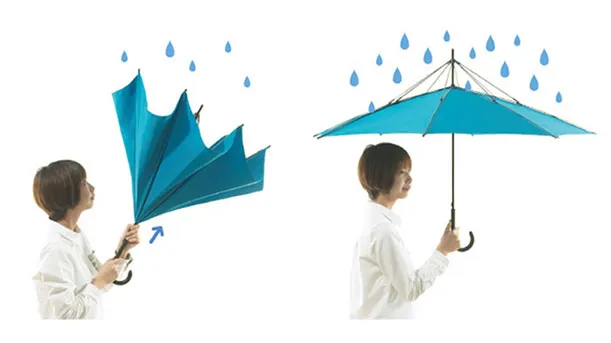Inventing the Perfect Umbrella
Will a Japanese designer’s new take on umbrellas catch on where others have failed?
/https://tf-cmsv2-smithsonianmag-media.s3.amazonaws.com/filer/01/e8/01e869d1-71a8-46cb-8b64-7ab312d49d63/senz_umbrella.jpg)
Umbrellas shield people from the rain, but the current design is far from perfect. They fold down into soaked, dripping messes, crumple when hit by powerful blasts of wind and fail to safeguard us from muddy puddle splashes.
Recently, a handful of designers have put forth their best revisionist ideas for shoring up some of these deficiencies. There’s the Rain Shield, which features an enlarged canopy that extends, sort of like a tail on a tuxedo, down one side. This extra coverage guards against incoming splash while also preventing forceful gusts from catching the inside of the umbrella. The Rainshader resembles a blown-up motorcycle helmet (without the face guard). Hugging the user's head, this version is designed to not interfere with people's views at crowded events like concerts or games and to prevent poking others. The Senz umbrella, another oddly-shaped reboot that comes in the shape of a stealth fighter, is aerodynamically formulated to channel wind flow across the surface, in a way that won't cause it to flip over. The company claims the Senz can withstand winds of up to 70 mph.
None of these improvements, however, has the makings of a true evolutionary leap for the old school rain cover—at least not yet. Each concept, while mitigating one flaw, propagates others. For example, the Rain Shield's unorthodox shape requires that the user skillfully twists it down to size, similar to folding down those mesh pop-up hampers. Using a Rainshader can feel a bit confining while appearing to others as if you're wearing a "nylon mullet." And if you're thinking of sharing the Senz umbrella with someone else, forget about it. Coverage is entirely lopsided.

The latest to try his hand at a 2.0 version is Japanese designer Hiroshi Kajimoto. With the collapsing frame on the outside, his new creation, the inside out folding UnBRELLA, is not only better at resisting wind, but also folds upward to keep the wet surface inside and away from yourself and others. The ability to quickly funnel and drain the excess water also means you'll have more space in the living room, without an array of open wet umbrellas left out to dry. It even stands up to drip dry.
The most obvious drawback, however, is that, when folded, it nearly doubles the length of a conventional umbrella. Again, there's something about these efforts to revolutionize a tool that's been around and has remained, at its core, mostly unchanged for a millennium that comes off like trying to reinvent the wheel. It's understandably tempting for designers to try their hand at something that's intuitively simple enough, yet has befuddled numerous imaginative minds before them. The Telegraph has even called the challenge to improve the umbrella the holy grail of amateur inventors.

"The rewards for whoever improves the umbrella are substantial," writes Susan Orlean in the New Yorker. "The annual retail market in the United States alone is now $348 million—about 33 million umbrellas. The rest of the world, including many cultures where umbrellas are used both as rain protection and as sun shade, consumes many millions more."
But perhaps, when it comes down to it, people have grown too accustomed to the distinguished aesthetic of a perfectly circular hat on a stick that simply opens and folds when we need it. They'd like it to stay cheaply disposable enough to forget in taxi cabs, parties and other public nooks. Maybe, it's fine the way it is.
"It’s hard to improve on the umbrella," writes designer Charles Lim at Crooked Pixels. "A better umbrella would have to be easier to recycle or repair, or would be constructed from carbon fibre to make it both durable and light. But why even bother? Umbrellas are perfect because of their price and size. It’s a satisfied and dry market."
/https://tf-cmsv2-smithsonianmag-media.s3.amazonaws.com/accounts/headshot/tuan-nguyen.jpg)


/https://tf-cmsv2-smithsonianmag-media.s3.amazonaws.com/accounts/headshot/tuan-nguyen.jpg)